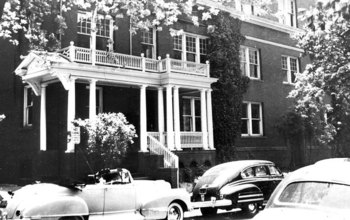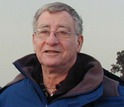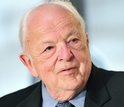News Release 16-054
On its 66th birthday, National Science Foundation living up to envisioned legacy
First class of research fellows set the standard for NSF excellence

NSF awarded its first research grants from this building on California Street in Washington. D.C.
May 10, 2016
This material is available primarily for archival purposes. Telephone numbers or other contact information may be out of date; please see current contact information at media contacts.
Today marks the National Science Foundation's (NSF) 66th birthday. After long debates in the mid-1940s, President Harry S. Truman signed legislation on May 10, 1950 establishing NSF.
At the time of signing, the president issued a statement saying, "Our ability to grow as a nation depends to a very large degree upon our scientific progress." It's fitting, then, that NSF's legacy is full of trajectory-changing research and researchers. One way the foundation supports those researchers is through its Graduate Research Fellowship Program (GRFP), which has recognized and supported outstanding graduate students for over six decades.
For example, in 1960, NSF provided graduate research funding for engineer for Ray Dolby, who invented the Dolby noise reduction system and helped develop the video tape recorder. In 1966, NSF funded molecular biologist Nina Federoff, who discovered how plants adapt to stressful environments. In 1992, the foundation funded economist Steven Levitt, who coauthored the book "Freakonomics," which applies economic theory to nontraditional topics. And in 2004, NSF funded social psychologist Jennifer Richeson, who used studies of racial identity and interracial interactions to improve awareness and mitigate racial bias.
Federal support for these researchers comes from NSF's legislative mandate, "to award ...scholarships and graduate fellowships for study and research in the sciences or in engineering."
In the year after Truman signed NSF's founding legislation, staffers worked to establish the nuts and bolts of how the new foundation would work. In 1952, NSF awarded its first graduate fellowships, launching what would become the oldest federal graduate research program of its type in the United States.
In addition to funding the above fellows, the first group of researchers who were awarded fellowships in 1952 was one of NSF's most highly decorated. It included:
- Evolutionary biologist and 1979 Pulitzer Prize winner Edward O. Wilson, who studies the social behavior of insects. He won the Pulitzer Prize for two nonfiction books, "On Human Nature" and "The Ants," in which he translated his research for general audiences.
- Physical chemist and National Institutes of Health Distinguished Investigator Gary Felsenfeld, who discovered the first three-stranded helical nucleic acid molecule and revealed the wide range of structures that nucleic acids can form.
- Chemist and former head of the Carnegie Institution of Washington Maxine Frank Singer, who helped decode how DNA creates life-sustaining proteins. She also produced synthetic nucleotides that helped determine the triplet nature of the genetic code and later called attention to the risks of genetic engineering.
- Mathematician Richard Palais, who was, in part, responsible for several geometric theorems and mathematics propositions including the Mostow-Palais theorem, the Lie-Palais theorem, the Morse-Palais lemma and the Palais-Smale compactness condition. Palais also is responsible for the Principle of Symmetric Criticality that demonstrates the invalidity of certain mathematical tests.
- Physicist and 1976 Nobel Prize winner Burton Richter, who co-discovered the subatomic particle known as the J/ψ meson. The discovery, reported by Richter at the Stanford Linear Accelerator Center and Samuel Ting at the Brookhaven National Laboratory, kicked off a number of changes in understanding high-energy physics at a time that has come to be known as the "November Revolution."
The selection and accomplishments of this first class of graduate research fellows would signal a U.S. future that would be profoundly impacted by NSF-funded researchers.
In the 66 years since Truman's signature, NSF has grown into its mission to "high-quality research and education programs and to maintain its competitive position at the forefront of modern science, engineering, and technology" to a point where its research grants and scholarships reach nearly 2,000 colleges, universities and other institutions in all 50 states. There, they fund fundamental research and education in all fields of science and engineering.
In some cases, it took decades for the work of NSF's first class of graduate researchers to bear fruit. Still, every year NSF supports more graduate research fellows. What legacy will investments in the next class of young, NSF-funded researchers leave?
-NSF-
-
Evolutionary biologist and Pulitzer Prize winner Edward O. Wilson, a 1952 Graduate research fellow.
Credit and Larger Version -
Physical chemist and National Institutes of Health Distinguished Investigator Gary Felsenfeld.
Credit and Larger Version -
Former head of the Carnegie Institution of Washington Maxine Frank Singer.
Credit and Larger Version -
University of California, Irvine mathematician and 1952 Graduate Research Fellow Richard Palais.
Credit and Larger Version -
1976 Nobel Prize winner Burton Richter.
Credit and Larger Version
Media Contacts
Bobbie Mixon, NSF, (703) 292-8070, email: bmixon@nsf.gov
The U.S. National Science Foundation propels the nation forward by advancing fundamental research in all fields of science and engineering. NSF supports research and people by providing facilities, instruments and funding to support their ingenuity and sustain the U.S. as a global leader in research and innovation. With a fiscal year 2023 budget of $9.5 billion, NSF funds reach all 50 states through grants to nearly 2,000 colleges, universities and institutions. Each year, NSF receives more than 40,000 competitive proposals and makes about 11,000 new awards. Those awards include support for cooperative research with industry, Arctic and Antarctic research and operations, and U.S. participation in international scientific efforts.
Connect with us online
NSF website: nsf.gov
NSF News: nsf.gov/news
For News Media: nsf.gov/news/newsroom
Statistics: nsf.gov/statistics/
Awards database: nsf.gov/awardsearch/
Follow us on social
Twitter: twitter.com/NSF
Facebook: facebook.com/US.NSF
Instagram: instagram.com/nsfgov





